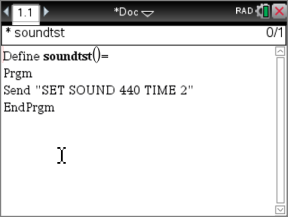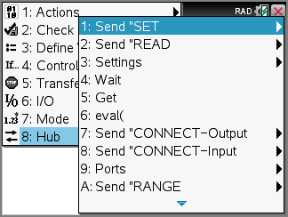Hub Programming on TI‑Nspire™ CX Technology
Note: These instructions apply to TI‑Nspire™ CX technology. For similar instructions for TI CE graphing calculator, refer to Hub Programming on TI CE Graphing Calculator (here).
The TI‑Innovator™ Hub responds to TI Basic programming commands such as and .
|
•
|
Send - Sends command strings to the Hub to control devices or request information. |
|
•
|
Get and GetStr - Retrieve information requested from the Hub. |
|
•
|
eval() - Supplies the result of an expression as a character string. Valid only within Send, Get, and GetStr commands. |
|
•
|
Wait - Pauses program execution for a specified number of seconds. |
Code Examples: TI-Nspire™ CX Technology
|
Turn on the on-board Red LED ("LIGHT").
|
Send "SET LIGHT ON"
|
|
Play a 440Hz tone on the on-board speaker ("SOUND") for 2 seconds.
|
Send "SET SOUND 440 TIME 2"
|
|
Turn on blue element of on-board RGB LED ("COLOR") at 100% brightness.
|
Send "SET COLOR.BLUE 255"
|
|
Read and display the current value of the on-board light sensor ("BRIGHTNESS"). Range is 0% to 100%.
|
Send "READ BRIGHTNESS"
Get a: Disp a
|
Sample Program to Blink an On-Board LED
The following TI‑Nspire™ CX program uses the Send and Wait commands to blink the on-board red LED in the Hub. The commands are contained in a "For...EndFor" loop that repeats the ON/OFF blink cycle for 10 iterations.
Define blink()=
Prgm
For n,1,10
Send "SET LIGHT ON"
Wait 1
Send "SET LIGHT OFF"
Wait 1
EndFor
EndPrgm
|

|
How to Create and Execute a Program
Note: These are abbreviated instructions. For detailed instructions, refer to the TI‑Nspire™ CX Program Editor.
Before You Begin:
|
▶
|
Refer to System Requirements (here), and update your software as needed. |
|
-
|
On TI‑Nspire™ CX handhelds, use TI‑Nspire™ computer software to update the Operating System. |
|
-
|
On computers running TI‑Nspire™ CX software, use the Help menu to update the software. |
To Create a New Program in a TI‑Nspire CX Document:
|
1.
|
On the handheld, press ~ and select .
From the computer software, click . |
|
2.
|
Type a name for your program, such as "soundtst," select as the Type, and then click . |
The Program Editor opens, displaying a template for your program code.
|
3.
|
Between the and lines, type the lines of code that make up your program. |
|
-
|
You can either type command names or insert them from the Program Editor menu. |
|
-
|
After typing each line, press to type additional code. |
|
-
|
Use the arrow keys to scroll through the program. |
To Store the Program:
You must store your program before you can run it.
|
▶
|
On the handheld, press b and select .
On the Program Editor menu, click . |
To Close the Program Editor
|
▶
|
On the handheld, press b and select .
On the Program Editor menu, click . |
If you have made changes since storing the program, you are prompted to Check Syntax & Store.
To Run the Program:
|
1.
|
Ensure that the TI‑Innovator™ Hub is connected to your handheld or computer. |
|
2.
|
Ensure that any needed I/O Modules or Breadboard components are connected to the Hub. |
|
3.
|
Open the document that contains the program. |
|
4.
|
On a Calculator page, type the program name and parentheses. If the program requires arguments, enclose them in the parentheses, separated by commas. |
The program runs.
To Edit an Existing Program:
|
1.
|
If necessary, open the document that contains the program. |
|
2.
|
Go to a Calculator page. |
|
3.
|
On the handheld, press b and select .
On the Calculator menu, click . |
|
4.
|
Select the program name name from the displayed list. |
The program appears in a Program Editor page.
Using the Hub Menu to Build Commands
The Hub menu is available on the TI‑Nspire™ CX technology anytime you are creating or editing a program. It can save you time building commands and help you with correct command spelling and syntax.
Note: To build a command from the Hub menu, you need to know:
|
•
|
The unique name of the component that you are addressing, such as "SOUND" for the on-board speaker. |
|
•
|
The command parameters that apply to the component, such as sound frequency and duration. Some parameters are optional, and you might need to know the value range of a parameter. |
Example of Using the Hub Menu:
This TI‑Nspire™ CX example builds the command Send "SET SOUND 440 TIME 2" to sound a 440Hz tone for 2 seconds on the on-board speaker.

|
1.
|
Open (or create) the program that you will use to communicate with the Hub. |
|
2.
|
Position the cursor where you want to place the command. |
|
3.
|
On the handheld, press b and select .
In the Program Editor menu, select .
|
The Hub menu appears.
|

|
|
4.
|
Select , and then select to insert the first part of the command. |
|

|
|
5.
|
Type 440 as the frequency value. |
|

|
|
6.
|
On the Hub menu, select . |
|

|
|
7.
|
To complete the command, Type 2 as the TIME value. |
|

|
|
8.
|
To test the command, follow the previous instructions for running a program. |
Tips for Coding with TI‑Nspire™ CX Technology
|
•
|
Code from an external source might contain "curly" quotation marks (“...”) in places that require straight quotes ("..."). To type straight quotes, press / r. |
|
•
|
To clear the current line of code, press / Ì. |
|
•
|
To type relational operators such as =, <, and ≤, press / =. |
|
•
|
To type a space, press _. |
|
•
|
If your program becomes unresponsive while running: |
TI‑Nspire™ CX Handheld: Hold down the c key and press · repeatedly.
Windows®: Hold down the key and press repeatedly.
Mac®: Hold down the key and press repeatedly.


